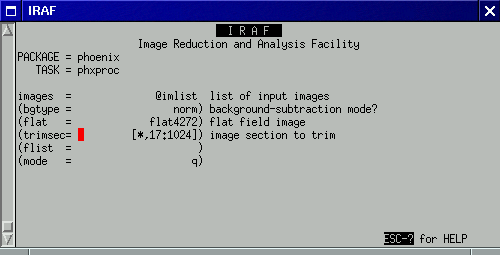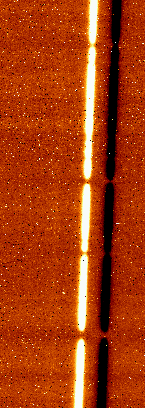
Click here for text parameters
epar phxproc

phxproc is pretty self-explanatory... just provide your list of images, prefixed with the @ symbol, your flat field frame, and the section of the image to trim (in this case, chop off the lowest 16 rows). The only nuance is the bgtype parameter, which defines how the sky is subtracted:
| bgtype parameter | Sky subtraction behavior |
| norm | This is default. It assumes that adjacent frames may be subtracted from one another, i.e. A-B-A-B.... In fact, BOTH adjacent sky frames will be averaged together and then subtracted! Assumes that you are wobbling along the slit, so there is data AND sky in every frame. |
| alt | Alternate frames contain data, separate sky frames are interleaved. This is necessary for large extended sources that prohibit wobbling along the slit. |
| alt2 | Similar to alt, except that there are two consecutive on-source frames for every sky frame... i.e. A-B-B-A-B-B-(etc.). This increases observing efficiency for large extended sources that prohibit wobbling along the slit. As the quality of the sky subtraction suffers, it should only be used during relatively stable conditions, and at J-K bands. |
All set? Okay, hit :g and let phxproc crunch away on your data. When you are done, your processed files will have a .r attached to the filename (i.e. data001.fits becomes data001.r.fits) and you can look at them using display or all at once using mdisp.
Below is a sample of a single sky-subtracted, flat-fielded, and trimmed image... the same image as the raw one we saw earlier. Doesn't it look so much better? The second image is a 1:1 zoom on the center of the array. Notice that numerous warm pixels have not subtracted out. They will have to be masked or otherwise rejected, or they will compromise the integrity of the data. More on this soon...


 Selecting Files for Bulk Processing Selecting Files for Bulk Processing |
Combining images  |